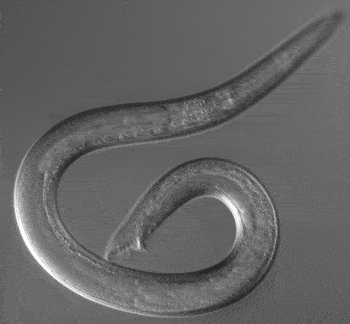In a remarkable feat of science, scientists at Harvard University have surpassed seemingly insurmountable technological challenges have managed to take over the behavior of a lab worm. Using precisely targeted laser pulses at the worm’s neurons, scientists were able to direct it to move in any directions they wanted, and even trick it in thinking there’s food nearby. These fantastic results provide an important milestone in the quest to understand how sensory information is transmitted into behavior.

The researchers used the favored lab testing specimen, the common Caenorhabditis elegans (C. elegans) worm, to test their theories, which they genetically altered in order for its neurons to give off fluorescent light, allowing them to be tracked during experiments. Also, genes in the worm were altered to make its neurons sensitive to light, so they could be stimulated with pulses of light – this is optogenetics.
“If we can understand simple nervous systems to the point of completely controlling them, then it may be a possibility that we can gain a comprehensive understanding of more complex systems,” said team leader Sharad Ramanathan, an Assistant Professor of Molecular and Cellular Biology and of Applied Physics. “This gives us a framework to think about neural circuits, how to manipulate them, which circuit to manipulate and what activity patterns to produce in them.
“Extremely important work in the literature has focused on ablating neurons, or studying mutants that affect neuronal function and mapping out the connectivity of the entire nervous system. ” he added.
“Most of these approaches have discovered neurons necessary for specific behavior by destroying them. The question we were trying to answer was: Instead of breaking the system to understand it, can we essentially hijack the key neurons that are sufficient to control behavior and use these neurons to force the animal to do what we want?”
Taking over a worm’s brain
Targeting the worm’s neurons with laser pulses, however proved to be an incredible challenge. The researchers manage to overcome the difficulties they faced though, like developing a movable table which keeps the worm centered to the laser beam no matter how fast or in what direction it might move, and implementing a custom-built computer hardware and software to insure the laser pulses fire at the required split-second speeds – once every 20 milliseconds, or about 50 times a second.
“The goal is to activate only one neuron,” Ramanathan said. “That’s challenging because the animal is moving, and the neurons are densely packed near its head, so the challenge is to acquire an image of the animal, process that image, identify the neuron, track the animal, position your laser and shoot the particularly neuron”
They discovered that controlling the dynamics of activity in just one interneuron pair (AIY) was sufficient to force the animal to locate, turn towards, and track virtual light gradient. What was mind blowing, for me to learn at least, was that the scientists didn’t only manipulate the worm’s behavior, but its senses also. They proved this by tricking the worm’s brain into believing food was nearby, causing it to make a beeline toward the imaginary meal.
“By manipulating the neural system of this animal, we can make it turn left, we can make it turn right, we can make it go in a loop, we can make it think there is food nearby,” Ramanathan said. “We want to understand the brain of this animal, which has only a few hundred neurons, completely and essentially turn it into a video game, where we can control all of its behaviors.”
Before you form any modern Manchurian candidate paranoia influenced ideas, consider that C. elegans has one of the most primitive brains, as far as complex organisms are concerned – boosting a disappointing 302 neurons. It’s impossible for a similar set-up to render similar results for a snake, let alone a human. Still, the Harvard researchers intend of improving their system and test on more complex organisms.
Findings were published in the journal Nature.


